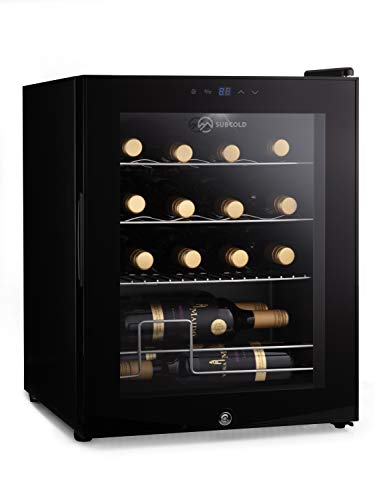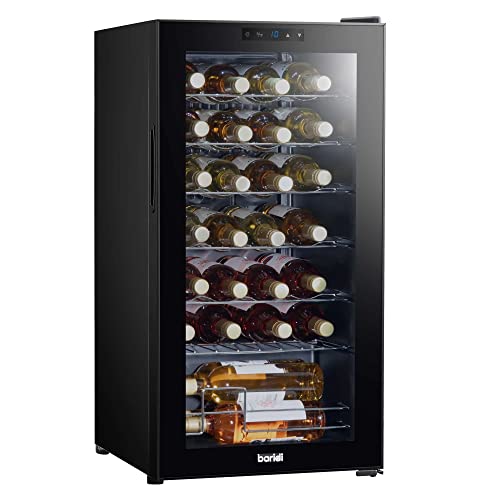The Benefits of a Wine Fridge Cooler
A wine refrigerator keeps bottles at the ideal temperature for aging. A well-designed wine fridge regulates humidity levels to keep corks from drying out and oxidizing.
 Select a wine refrigerator that has several temperature zones. This is a great feature if you collect different types of wine with different requirements for storage.
Select a wine refrigerator that has several temperature zones. This is a great feature if you collect different types of wine with different requirements for storage.
Compressor-Based Cooling
Wine fridge coolers use compressor technology to keep your wine at the optimal temperature for serving or long-term storage. This kind of cooling system is more commonly found in beverage refrigerators. It ensures a constant temperature throughout the inside of the refrigerator which makes it a great option for wine storage.
Wine refrigerators equipped with this cooling technology are available in freestanding or built-in models, which allow you to easily incorporate the perfect wine storage solution to your kitchen, bar area, wine cellar or closet. They can be mounted under counter wine cooler counters, recessed and in many cases have front vents so that they blend in seamlessly with the other kitchen appliances.
In addition to maintaining the right temperature, wine refrigerators that use this cooling technology can also perform other essential functions that are important for storing wine. For example, they can be equipped with a humidity control system that checks the air inside the refrigerator and adjusts the water flow to ensure that wine bottles are properly humidified. This prevents oxidation, which can alter the flavor of the wine.
Some wine coolers have dual or even triple temperature zones, so you can store various types of wine at the right temperature. This is a great choice for those who want to serve both white and red wines, or wish to separate their wine collection into different storage categories.
Some wine refrigerators use this type of cooling to create an UV-resistant door that shields the wine from harmful ultraviolet radiation.
In addition to their capacity to cool wine to the right temperature, wine refrigerators that use this technology are generally silent and do not produce any vibrations. They do not use liquid refrigeration and thus do not have moving parts that vibrate or cycle when they are running. This reduces the vibrations that can cause loose hardware and other issues within the small wine fridge uk fridge cooler. It also helps reduce the sound generated by the cooling system and ensure your wine tasting at its best.
Thermoelectric cooling
Thermoelectric cooling is an entirely different kind of technology compared to compressor-based units. Instead of refrigerants thermoelectric coolers rely on the Peltier effect to keep wine bottles cool. The Peltier effect occurs when an electrical current is passed through two metal pieces that are connected and causes one side to warm while the other cools down. This temperature difference is what allows the cooler to maintain a cool environment inside of the cabinet.
In most cases, a heat sink is used to distribute cold air throughout the cabinet. It is usually an electrolyzed piece of aluminum that expands its surface to help dissipate heat. Fans are situated at either end of the heat sink to circulate air and keep the temperature constant.
This technology is environmentally friendly. Thermoelectric coolers are green since they don’t require refrigerants. They also consume far less energy and so are typically less expensive to run than their compressor-based counterparts.
However it is important to know that thermoelectric wine coolers are not as efficient in keeping wine bottles at their optimal temperature as compressor units. This is because they are not able to reach the temperature they should be. They also require more maintenance since they are always running.
In addition to their energy efficient and environmentally friendly capabilities thermoelectric wine refrigerators are also quiet. This makes them a fantastic choice for those who live in homes or restaurants where it is important to preserve the atmosphere of the area. They are also ideal for living rooms where people love to entertain guests or have a glass of wine on their own. This is because they can be set up in any room in the house or restaurant without creating disturbance. This is because they don’t depend on any motors or compressors that are noisy.
Humidity Control
Wine is sensitive to its environment and requires precise conditions to mature properly. The temperature and humidity play important parts in the process, protecting cork integrity and preserving quality as time passes. A wine fridge keeps an ideal temperature range and controls humidity to ensure a perfect maturation process.
The ideal humidity for storing wine can be found between 50 and 70 percent. When humidity levels drop the wine will lose its taste and develop the oxidation. Mold and mildew can also thrive in extreme humidity, which could damage labels or alter the quality of cork. Wine fridges provide a space that hinders mold and mildew growth, while protecting the appearance and taste of wines.
Many wine refrigerators come with humidity control systems to ensure appropriate levels of humidity. These systems incorporate an inbuilt hygrometer which monitors the air temperature in the wine cellar and then automatically adjusts humidity settings to keep it within the desired range.
In addition, some wine fridges are designed with internal fans that aid in the circulation of air and help prevent pockets of humid or warm air from creating. This ensures constant temperatures throughout the wine storage space and decreases energy usage by limiting fluctuations in temperature.
Lastly, most wine fridges have doors that are solid or dual-paned which provide insulation and protection from harmful UV rays which can alter the chemical composition of wine and alter the flavor. Some wine fridges are equipped with vibration-reduction mechanisms to minimize disturbances that could cause sediment to be disturbed in older bottles or disrupt the aging process.
While passive cooling techniques are effective for the reduction of humidity, you may require introducing additional moisture in your wine refrigerator if it has been operating under insufficient conditions for extended periods of time. Air dehumidifiers and moisture absorbers made of mineral salts or crystals are a short-term solutions to absorb water vapour from the air. They should be emptied and replaced on a regular basis. If you’re looking for a long-term solution, install an active air humidification system that uses both water atomizers and a tank of water.
Capacity of Storage
A wine fridge is an asset if enjoy wine regularly and want to keep a few bottles on hand for unplanned or spontaneous occasions. These devices recreate the optimal conditions of natural caves and cellars to allow your wine to get the best flavor over time.
Wine is a delicate mix of various compounds that interact to create distinct aromas and flavors. A proper storage environment will preserve these properties, and will prevent premature aging. This can deprive the wine of its true essence. In a standard refrigerator, fluctuations in temperature can damage these molecules and cause the flavors to diminish. In a wine fridge, humidity control and constant temperatures will prevent these problems.
In addition to maintaining ideal temperatures, wine refrigerators regulate humidity levels to prevent corks from drying out and leaking. If a wine bottle is kept in a dry environment the labels could be removed and the wine will lose its flavor. Wine fridges keep relative humidity levels between 55% and 75 % to protect the quality and integrity of wine bottles.
These cooling systems typically feature internal fans that ensure that air circulation is uniform throughout the cabinet. This helps eliminate pockets of warm or humid air, and ensures that the collection is at an even temperature. Many units also come with racks and shelves that are designed to gently and securely hold bottles. This will protect your bottles from damage and help you effectively organize them.
Some wine fridges have dual temperature zones, which are useful to store different kinds of wine at their optimal temperatures. Other features common to these devices include UV-resistant doors as well as LED lighting. These features block harmful sunlight from reaching your wine and make them easy to find. Some wine refrigerators have carbon filters to cut down on the odors of air that could seep through the corks of bottles and alter the flavor of the wine.
When you are looking for a wine cooler, take into consideration the amount of space you have available and how extensive your collections are. Wine coolers are available in many sizes and shapes. They can be installed under counters or cabinets. Some have front venting which means they can be put in smaller spaces. Some wine refrigerators have shelves that can be adjusted, allowing you to fit bottles with unusual shapes.
